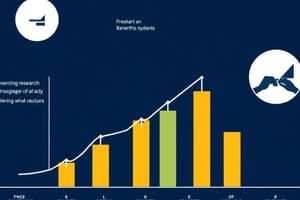Podcast
Questions and Answers
Which of the following is NOT a benefit of staying informed about market developments?
Which of the following is NOT a benefit of staying informed about market developments?
- Improving project alignment with broader strategies
- Understanding internal organizational structures (correct)
- Identifying new opportunities
- Anticipating challenges
What is the main purpose of a SWOT analysis in the context of gaining knowledge about your organisation and industry sector?
What is the main purpose of a SWOT analysis in the context of gaining knowledge about your organisation and industry sector?
- To identify competitors and their market share
- To evaluate the effectiveness of current marketing strategies
- To assess your organisation's strengths, weaknesses, opportunities and threats (correct)
- To create a marketing plan for new products and services
Which of the following is an example of external analysis when gaining knowledge about your organisation and industry sector?
Which of the following is an example of external analysis when gaining knowledge about your organisation and industry sector?
- Analyzing competitor activities (correct)
- Reviewing financial reports
- Evaluating internal communication channels
- Assessing employee satisfaction
What is the primary benefit of conducting a comparative study in the context of project development?
What is the primary benefit of conducting a comparative study in the context of project development?
Which of the following data sources is considered secondary data?
Which of the following data sources is considered secondary data?
What is the primary advantage of gathering both qualitative and quantitative data for a research project?
What is the primary advantage of gathering both qualitative and quantitative data for a research project?
How does knowing the needs of your target audience contribute to the success of your project?
How does knowing the needs of your target audience contribute to the success of your project?
Which of the following is NOT a key aspect of gaining in-depth knowledge of your organisation and industry sector?
Which of the following is NOT a key aspect of gaining in-depth knowledge of your organisation and industry sector?
What is the primary benefit of combining qualitative and quantitative data in research?
What is the primary benefit of combining qualitative and quantitative data in research?
Which step is NOT part of the comprehensive research process outlined?
Which step is NOT part of the comprehensive research process outlined?
What should be the first step in the research process?
What should be the first step in the research process?
What type of data collection methods can be categorized as primary data?
What type of data collection methods can be categorized as primary data?
What is a SWOT analysis used for in the research process?
What is a SWOT analysis used for in the research process?
What is the primary purpose of a literature review in research?
What is the primary purpose of a literature review in research?
Which of the following is NOT a component of assessing data sources in research?
Which of the following is NOT a component of assessing data sources in research?
What is an essential step when analyzing relevant legislation for a project?
What is an essential step when analyzing relevant legislation for a project?
Which method is NOT typically considered a research method for gathering data?
Which method is NOT typically considered a research method for gathering data?
What role does understanding external trends play in research?
What role does understanding external trends play in research?
What is the primary goal of gathering actionable insights in research?
What is the primary goal of gathering actionable insights in research?
How should research methods be selected for a given project?
How should research methods be selected for a given project?
What is the significance of critically evaluating existing concepts during a literature review?
What is the significance of critically evaluating existing concepts during a literature review?
What is the primary goal of conducting research for a management project?
What is the primary goal of conducting research for a management project?
Which data type is NOT mentioned as being relevant to management project research?
Which data type is NOT mentioned as being relevant to management project research?
Why is understanding market trends important for conducting management project research?
Why is understanding market trends important for conducting management project research?
Which of these is NOT a key activity involved in conducting management project research?
Which of these is NOT a key activity involved in conducting management project research?
What is the benefit of conducting comparative studies for management project research?
What is the benefit of conducting comparative studies for management project research?
Which of the following is NOT a characteristic of data considered to be sufficient in the context of management project research?
Which of the following is NOT a characteristic of data considered to be sufficient in the context of management project research?
How does research enable informed decisions in a management project?
How does research enable informed decisions in a management project?
Flashcards
Research in project management
Research in project management
Gathering and analyzing data, information, and knowledge to base project decisions on.
Research quality criteria
Research quality criteria
Ensuring the quality and reliability of the collected information.
Literature review
Literature review
Examining existing theories and studies to understand the current knowledge base.
Legislation and industry standards analysis
Legislation and industry standards analysis
Signup and view all the flashcards
Market trends analysis
Market trends analysis
Signup and view all the flashcards
Organizational and industry knowledge
Organizational and industry knowledge
Signup and view all the flashcards
Comparative studies
Comparative studies
Signup and view all the flashcards
Data types in research
Data types in research
Signup and view all the flashcards
Selecting Research Methods
Selecting Research Methods
Signup and view all the flashcards
Data Assessment
Data Assessment
Signup and view all the flashcards
Theoretical Framework
Theoretical Framework
Signup and view all the flashcards
Knowledge Gaps
Knowledge Gaps
Signup and view all the flashcards
Legislation and Policy Analysis
Legislation and Policy Analysis
Signup and view all the flashcards
Understanding External Trends
Understanding External Trends
Signup and view all the flashcards
Market Research
Market Research
Signup and view all the flashcards
Define Objectives and Scope
Define Objectives and Scope
Signup and view all the flashcards
Conduct Literature Review
Conduct Literature Review
Signup and view all the flashcards
Understand External Trends
Understand External Trends
Signup and view all the flashcards
Collect Data
Collect Data
Signup and view all the flashcards
Combining Qualitative and Quantitative Data
Combining Qualitative and Quantitative Data
Signup and view all the flashcards
SWOT Analysis
SWOT Analysis
Signup and view all the flashcards
Primary Data
Primary Data
Signup and view all the flashcards
Secondary Data
Secondary Data
Signup and view all the flashcards
Comparative Study
Comparative Study
Signup and view all the flashcards
Qualitative Data
Qualitative Data
Signup and view all the flashcards
Quantitative Data
Quantitative Data
Signup and view all the flashcards
Organization and Industry Sector Knowledge
Organization and Industry Sector Knowledge
Signup and view all the flashcards
Staying Informed
Staying Informed
Signup and view all the flashcards
Study Notes
CMI Level 5 Management Project - Research
- Management projects require thorough and valid research for data-driven decisions.
- Research should gather sufficient, current, authentic, reliable, and valid data.
- Research forms the base for informed decisions in the project's lifecycle.
Research Involves
- Review of existing concepts, theories, and assumptions (literature review).
- Analysis of current knowledge landscape, relevant legislation, policies, and industry standards.
- Understanding market trends and the competitive environment.
- Deep knowledge of the organization and the wider industry.
- Comparative studies across organizations, countries, or cultures.
- Utilizing different data types (primary, secondary, qualitative, quantitative).
Types of Research Methods
- Reviewing existing literature (books, articles, industry reports).
- Critical evaluation of existing concepts, theories, and assumptions.
- Analysis of relevant legislation, policies, and industry standards.
- Understanding current market trends and competitive environment.
- Research into organizational context (SWOT analysis, reports, performance metrics).
- Sector and broader industry analysis.
- Comparative studies (case studies, interviews, benchmarking).
- Gathering primary data (surveys, interviews, experiments).
- Utilizing secondary data (reports, databases).
- Qualitative data (insights into behaviors, attitudes).
- Quantitative data (measurable, numerical insights).
Step-by-Step Research Guide
- Define project objectives & scope aligning with overall goals.
- Conduct a literature review to grasp current theories and identify knowledge gaps.
- Analyze relevant legislation and industry standards to ensure compliance.
- Understand external trends through market analysis, consumer surveys, etc.
- Assess organizational knowledge (SWOT analysis) and sector insights.
- Conduct comparative studies to benchmark practices.
- Collect quantitative and qualitative data using various methods.
Studying That Suits You
Use AI to generate personalized quizzes and flashcards to suit your learning preferences.




